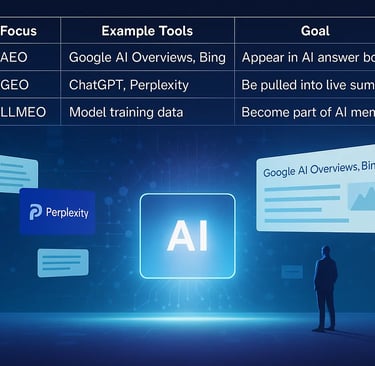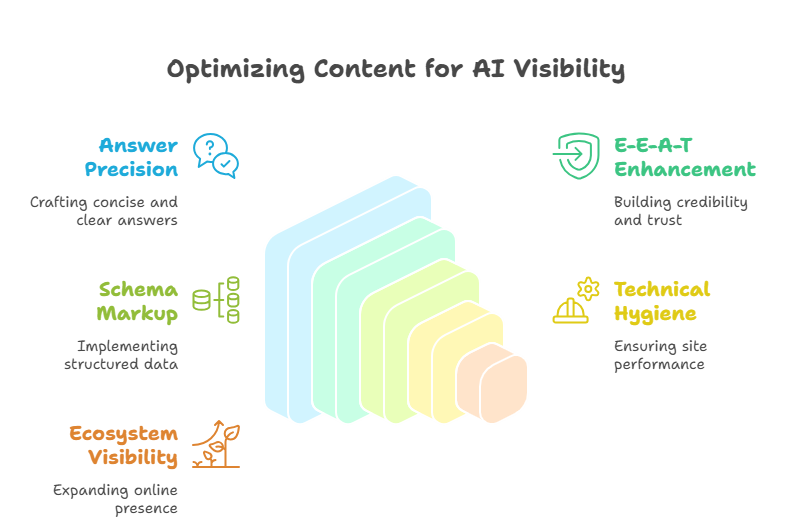AEO for B2B SaaS in 2025: How to Build AI-Friendly Content That Generates Leads
AI_SEO
7/17/20255 min read


AEO (Answer Engine Optimization) helps your SaaS content get quoted inside AI answers, not just ranked on Google. With AI tools summarizing instead of linking, visibility now depends on structure, trust signals, and schema, not traffic.
The shift no one prepared for
In Q1, a SaaS founder messaged us after publishing a 3,000-word guide on employee productivity software.
Not a single mention in AI summaries. No quote in Google’s AI Overviews. Zero from Perplexity.
The content was well-written, original. But not a single AI interface picked it up.
Why? Because it wasn’t written for them.
Most SaaS teams are still playing the wrong game.
SEO got us clicks.
AEO gets us cited.
That shift matters because user behavior has shifted.
More than half of all Google searches are now zero-click. The user gets what they need from the AI summary. No clicks. No visits.
In tools like ChatGPT, Perplexity, and Bing Copilot, the answer is the interface.
If you’re not in the answer, you’re invisible.
What is AEO?
AEO stands for Answer Engine Optimization. It’s the process of making your content easier to quote by AI systems like ChatGPT, Google AI Overviews, and Perplexity.
It’s not a replacement for SEO. It’s a parallel strategy.
Where SEO chases rankings, AEO earns citations.
Where SEO optimizes for traffic, AEO optimizes for trust.
Think of it as turning your content into something AI finds, understands, trusts, and quotes.
At Briskfab, we help B2B SaaS teams rework their existing content into formats AI engines prefer. That includes structuring copy for readability, adding missing schema, improving source signals, and distributing content to channels where AI systems train and source from.
AEO vs GEO vs LLMEO: Same Playbook, Different Interfaces
AEO (AI answers), GEO (live summaries), and LLMEO (training data) are variations of the same strategy. They all reward clear structure, credibility, and schema markup.


But they all reward the same behaviors:
Clear, structured writing
Factual content
Credible authorship
Schema markup
So if you follow AEO principles well, you’ll show up across all of them.
How AI Answer Engines Actually Work
AI doesn’t just rank links. It retrieves, summarizes, and decides what to quote.
Here’s the flow:
Retrieval — AI finds relevant content across sources
Generation — It drafts a response using what it finds
Attribution — It picks trusted sources to quote
Display — It shows a final answer, often without needing a click


What matters most isn’t ranking high—it’s being quotable.
What Gets You Cited
Data across 50+ B2B SaaS domains show clear patterns:
Structured answers (40–60 words) get quoted most often
Content with schema gets retrieved more frequently
Author bios and credible links improve source trust
Pages with clear headers and bullets outperform dense blogs
According to Statista, 54% of marketers globally now use AI tools for content optimization. Yet, only a fraction implement structured markup consistently.
Clicks might drop, but impressions and mentions go up. This is the new visibility loop.
Why This Matters for SaaS
At this stage, most SaaS teams aren’t just under-optimized—they’re invisible to AI systems.
This is where Briskfab fits in. We help SaaS brands repackage their content for the answer engine economy.
Not by writing more. But by:
Compressing answers to the top
Cleaning the structure for AI readability
Fixing weak trust signals
And distributing it beyond just your blog
AEO isn’t a nice-to-have—it’s a survivability tactic.
Across a sample of 75,000 search visits in Q2 2025, organic clicks dropped 57% for AI-triggered keywords—yet impressions rose 20%.
The 5 Pillars of AEO for SaaS
Answer Precision
Start with a 40–60 word direct answer
Use bullets, subheads, and clarity throughout
E-E-A-T (Experience, Expertise, Authoritativeness, Trust)
Add author bios, cite sources, show expertise
Link to original research or trusted third-party sources like Harvard Business Review
Schema Markup
Use FAQ, Q&A, How-To, and Organization schema
Test with Google Rich Results and Schema.org Validator
Technical Hygiene
Fast pages, clean HTML, logical content flow (H1 > H2 > H3)
Semantic internal linking and structured sections
Comply with Core Web Vitals
Mobile-first design is a must
Broader Ecosystem Visibility
Get cited in docs, forums, third-party blogs, Wikipedia
These signals help AIs prioritize your content


AEO Process: Step-by-Step for Content Optimisation.
Find the real questions
Use AnswerThePublic, AlsoAsked, and “People Also Ask”
Cover every stage from awareness to decision
Write AEO-ready content
Start with an answer
Structure with bullets and headers
Avoid intros and filler
Add schema
JSON-LD for FAQs, Q&A, How-To
Validate before and after publishing
Build off-site authority
Get quoted on review sites, podcasts, industry blogs
Publish original stats, benchmarks, or data
Engage in high-authority communities (Reddit, Stack Overflow)
Get discovered naturally
Ensure docs, product pages, and help articles are crawlable
Submit to aggregators like DevHunt or Product Hunt
Track your results
Common Mistakes to Avoid
Writing fluffy intros before the answer
Skipping schema markup
Overstuffing keywords
Publishing blogs for traffic, not structure
Focusing only on your site—not your ecosystem
Letting technical debt slow down performance
The Future of AEO
AI will make decisions, not just suggestions
Brands need to be part of the research and the recommendation
Multimodal answers are coming
Text won’t be enough; video, charts, and audio will play a role
Structured brand data submission
Some LLMs may allow verified data feeds, similar to product feeds today
Final Thought
In the AI answer world, being quoted beats being ranked.
If you adapt early, you shape the narrative.
If you delay, you’ll be quoting your competitors.
Briskfab works with B2B SaaS teams to operationalize this shift—from SEO-first to AI-visible. The earlier you adapt, the more defensible your brand becomes.
Curious:
Have you spotted your content inside an AI answer yet?
Are you seeing traffic or mentions from ChatGPT or Perplexity?
Let’s swap notes.
Frequently Asked Questions (FAQs)
1. Is AEO replacing SEO?
No. AEO complements SEO. While SEO drives rankings and traffic, AEO helps your content get quoted directly by AI systems.
2. Do I need to rewrite all my content for AEO?
Not necessarily. Start by optimizing your top-performing and evergreen content. Apply AEO principles like structured answers, schema markup, and authority signals.
3. What kind of content performs best in AEO?
Concise, well-structured content that answers a clear question. FAQs, definitions, how-to guides, and expert explainers perform particularly well.
4. How do I know if my content is being quoted by AI?
Use analytics tools like GA4, Looker Studio, or Profound to track sessions from AI tools like ChatGPT, Perplexity, and Bing Copilot. Monitor brand mentions using tools like Ahrefs Brand Monitor.
5. Does AEO help with branded search and lead quality?
Yes. When users see your brand quoted in AI summaries, they’re more likely to recall and trust you—leading to higher-intent visits and better conversions down the funnel.
6. How long does it take to see results from AEO?
Improvements in AI visibility typically take 30–60 days, depending on the crawl frequency and authority of your content.
